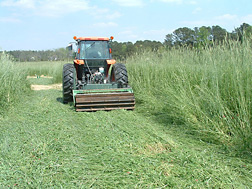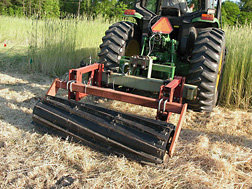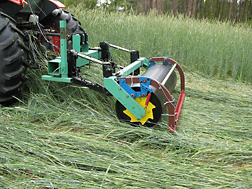The Roller in the Rye
Managing Cover Crops With Rolling and Crimping Techniques
|
|
Farmers could soon be on a roll when it comes to preparing their fields for planting.
That’s thanks to rolling machines—developed by Agricultural Research Service (ARS) scientists in Auburn, Alabama—that can quickly flatten mature, high-biomass cover crops such as rye.
Each roller consists of a long cylinder adorned with a series of evenly spaced, blunt, steel crimping bars, each about one-quarter-inch thick. As a standard tractor pulls the roller over the field, pressure from the bars flattens and damages the cover crop without cutting or uprooting it. Within 3 weeks, the rolled cover crop dries out, forming a mat of dead biomass into which farmers can plant cash crops such as cotton.
The rollers’ design is based on similar machines that have been used in South America for decades. Since 2001, ARS has been doing research to find the best crimping roller design for southeastern conditions, and benefits from this research are now becoming more widely recognized.
|
|
Heads (and Stalks) Will Roll
The one-pass process has plenty of benefits. It saves money, reduces soil erosion and runoff, helps control weeds, conserves water in the soil, and decreases—or eliminates—the need for herbicides.
In the southern United States and other regions where water-use efficiency is a concern, cover-crop rollers can also help maximize water storage.
“The rollers have the potential to help some producers save a lot of money,” says Randy Raper, an agricultural engineer at the ARS National Soil Dynamics Laboratory (NSDL) in Auburn. “Insufficient water results in lower yields, particularly here in the southern states, so any practice that stores water in the soil will result in greater crop productivity.”
The rolling technology can extend drought resistance by as much as 2 weeks, help producers manage high-biomass cover crops, and facilitate planting in no-till fields, Raper says.
Tall cover crops like rye have many benefits for no-till farming. They prevent erosion, reduce moisture evaporation, limit runoff, and increase infiltration and soil water-storage capability. But planting a cash crop in a sea of unruly cereal grains can be daunting for producers who are new to the task. The roller simply reduces cover crops to a flat layer of mulch. A planter, running parallel to the roller’s path, can plant seeds directly into the ground without significantly disturbing the biomass mat.
Because using a cover-crop roller can eliminate the herbicide required to kill a cover crop, it’s an ideal tool for organic farmers or other managers who want to reduce or eliminate herbicide use, according to Chris Lawrence, an agronomist with the USDA Natural Resources Conservation Service. Lawrence has helped farmers in Virginia experiment with the ARS rollers for herbicide-free, no-till management. Lawrence worked with Raper and NSDL agricultural engineer Ted Kornecki to design rollers with specifications to address the needs of the local community.
Lawrence worked with one farmer who rolled his fields before planting no-till certified-organic soybeans, with promising results. By using the rollers, the farmer was able to eliminate multiple tillage trips and dramatically reduce both tillage costs and erosion risk, compared to his normal clean-till planting practice.
The no-till beans weren’t as tall as a heavily tilled control group, Lawrence says, and had lower yields as a result. But the reduction in labor and fuel costs led to overall savings.
“After harvest, we estimated that the rollers had saved the farmer an average of $50 per acre,” he says.
Crimp My Rye
Auburn scientists have made several improvements to the original design, making rollers that are more effective and easier to use.
Kornecki and his colleagues compared the impact of three different roller designs (see photos at left). The first roller has a traditional design, with long, straight, horizontal bars. The second has diagonal bars that curve around the roller. The third has a smooth drum attached to a crimping bar that mashes the rye down as the machine moves forward.
NSDL scientists developed and patented the curved-bar roller and have a patent pending on the crimping roller design.
The scientists used each roller to flatten a rye cover crop and measured what percentage of the crimped plants died within 3 weeks. The scientists found that all three models killed enough rye—90 percent or more—to enable farmers to begin planting cash crops in the field. The third roller, which used the crimping bar, yielded the best results.
How does it work? The crimper uses a simple drum roller. As the machine rolls over the rye, a crimping bar attached to the drum rapidly pounds the flattened grain, damaging the stalks. The scientists also found that by spraying herbicide on every fourth crimp, they could kill 98 percent of the rye within a week, using 87 percent less Roundup (glyphosate) than would be required to kill nonrolled rye.
The NSDL team also examined the smoothness of each design. One drawback of the first cover-crop roller was excessive vibration, which could damage the tractor to which it’s attached and irritate the people maneuvering it.
“For a small farm, it’s less of a problem,” Kornecki says. “But a smoother ride is obviously more desirable.”
The scientists measured the vibrations of the rollers at various speeds and found that each model’s vibrations increased with higher operating speeds. Both the curved-bar and the crimping roller provided smoother rides than the traditional, straight-bar roller, allowing the cover crop to absorb most of the vibrations before they were transferred to the frame of the machine.
“With the crimping roller, all the energy is transferred to the cover crop, rather than to the tractor,” Kornecki says. “This reduces vibrations, and it kills the rye effectively.”
Future studies will help scientists maximize the efficiency and comfort of these machines. Kornecki is also developing new models to address different farming configurations—including one that could be used for crops grown in elevated beds and a lightweight model with two drums.
“We’re still fine-tuning the technology,” Raper says. “But these machines could have a major impact on sustainable farming.”—By Laura McGinnis, Agricultural Research Service Information Staff.
This research is part of Integrated Agricultural Systems (#207), an ARS national program described on the World Wide Web at www.nps.ars.usda.gov.
Ted S. Kornecki and Randy L. Raper are with the USDA-ARS National Soil Dynamics Laboratory, 411 S. Donahue Dr., Auburn, AL 36832; phone (334) 844-0908 [Kornecki], (334) 844-4654 [Raper], fax (334) 887-8597.
"The Roller in the Rye" was published in the September 2008 issue of Agricultural Research magazine.










